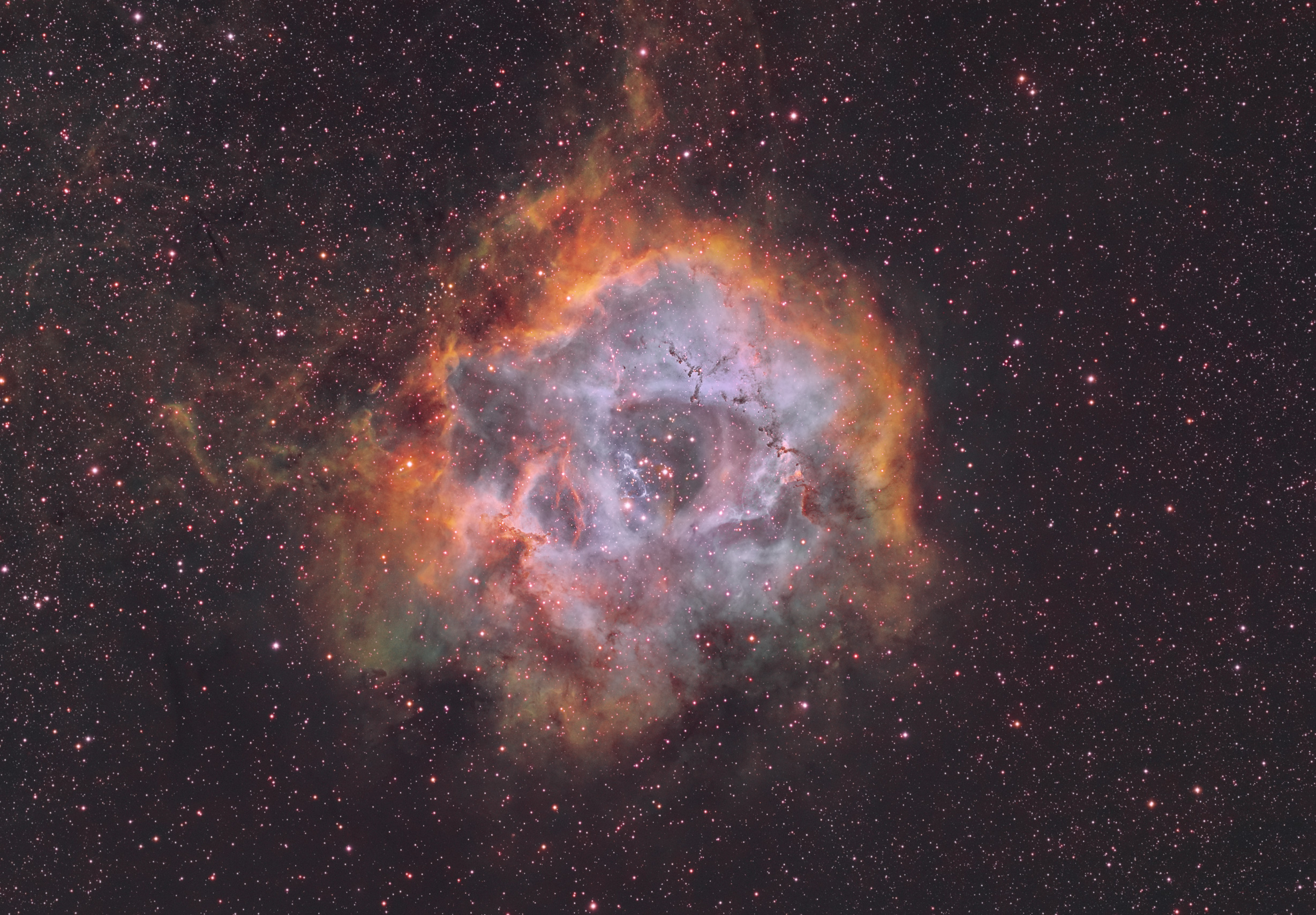A Rose of a Different Color: NGC 2237-2239 in SII, Ha, and
OIII
Characteristics:
Magnitude: 4.8 (for NGC 2244 star cluster in center)
Distance: 5500 light years
RA: 6h 32m 33s
Dec: 4 degrees 57' 05"
Position Angle: 0 degrees
Description:
The
Rosette Nebula is a winter showpiece for
astrophotographers, as
well as for visual observers at low power. This large emission
nebula is located in Monoceros and can be seen in dark locations with
the naked eye, especially if viewed through a UHC filter held up to the
sky. The nebula actually consists of several sections (NGC
2237-2239), with a central ladder like star formation known as NGC
2244. The central stars are young and newly-formed, and their
radiation is responsible for excitation of hydrogen atoms within the
nebula itself, which in turn emit light in the red at 656.3 nm
wavelength. Like most emission nebulae, however, the central
young stars emit high intensity radiation that also excites other types
of elements within the cloud to emit at their own characteristic
wavelengths. For instance, sulfur (SII) emits at 673.0 nm, and
OIII emits at 500.7 nm (most intense) and, to a lesser extent, at 495.9
nm. By using filters that capture SII, Ha, and OIII emission, it
is possible to map these colors into the more conventional R, G, and B
color palette, respectively. Assigning these narrowband images in
this order (highest to lowest wavelengths) to R, G, and B defines the
Hubble Palette, which is how the above image was constructed.
Spend some time on the larger images and notice where each element
overlaps, and where each element has a distinct, non-overlapping
location. For instance, the central portion of the nebula is more
intensely blue (OIII), whereas the peripheral "skirt" is a mixture of
reddish-orange (dominant SII with a touch of Ha) and yellow (equal
parts of SII and Ha). You can also see regions that are "apple
green" in color, representing an area that dominates in Ha (at 7
o'clock, for instance). The colors intermingle in various places
throughout the image, creating a fascinating and pleasing color
portrait that conveys important information about the relative signals
that are emitted from these locations. Rob Gendler's description
of the Rosette Nebula may be found here.
Photographic
Details:
Date: November 29 (Ha), December
11 (OIII), December 12 (SII), 2009
Scope: Takahashi
FSQ106 at f5 on the Takahashi NJP
Mount
Autoguider: SBIG ST-402 with
60mm guidescope, focal length 227mm
Camera: Apogee U16M at -20C, with
7 position 50mm square filter wheel (Apogee FW50-7S)
Filters: Baader
narrowband
filters, 50mm square
Exposures (20 minute subs): Ha, 240 minutes; OIII, 240 minutes,
SII, 300 minutes, all unbinned.
Total
exposure 13 hours
Post-processing:
Calibrated in Maxim, aligned and
stacked using DeepSkyStacker, followed
by DDP
in ImagesPlus (IP). Further processing in Photoshop CS (16
bit format) using the clipped layer mask method originally described by
Travis
Rector.
Please
note: Graphics on this website may not be reproduced without
author permission.
Back to Nebulae
Home

